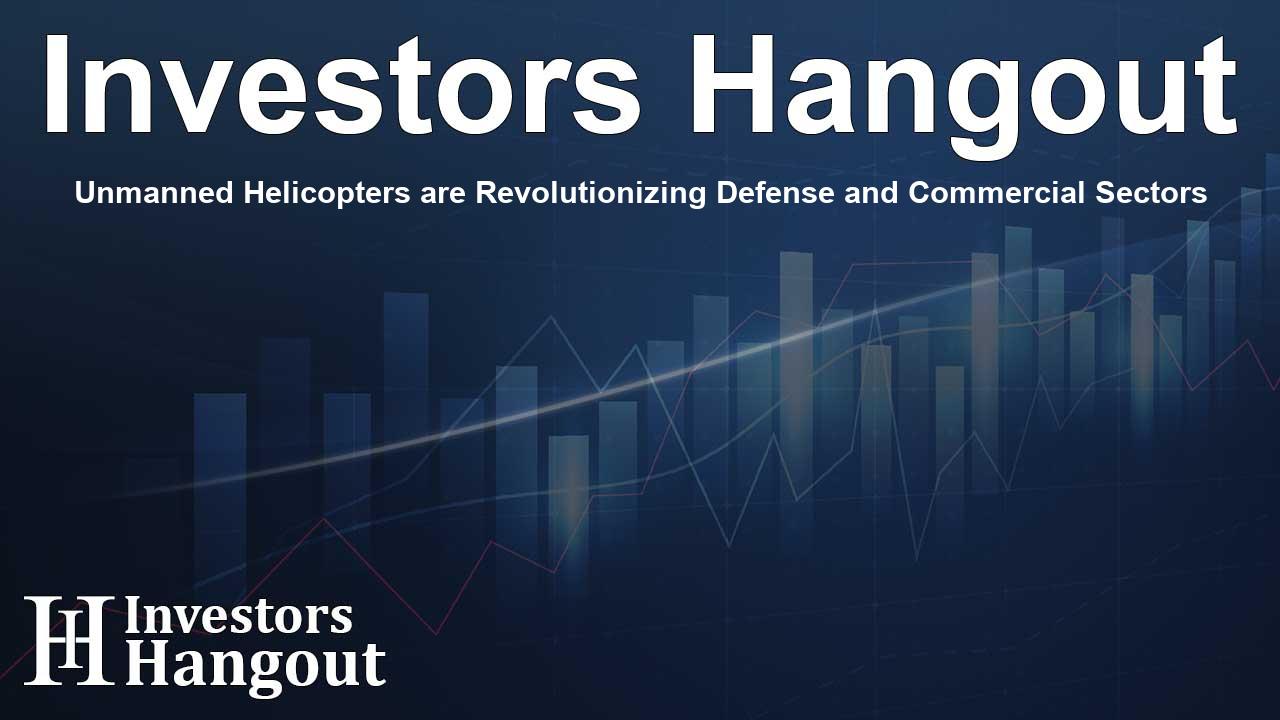Unmanned Helicopters are Revolutionizing Defense and Commercial Sectors

Unmanned Helicopter Market Overview
The Global Unmanned Helicopter Market is witnessing a remarkable transformation, driven by significant advancements in technology and growing requirements in defense and commercial sectors. Valued initially at USD 2,777.9 million, the market surged to USD 5,893.6 million by the middle of the decade and is expected to soar to USD 16,102.0 million by 2032, with a compound annual growth rate (CAGR) of 13.47% from 2025 to 2032. This growth reflects the increasing reliance on unmanned systems for operational efficiency and the safety of personnel.
Capabilities and Applications of Unmanned Helicopters
Unmanned helicopters, known for their Vertical Take-Off and Landing (VTOL) capabilities, offer distinctive benefits that set them apart from conventional fixed-wing aircraft. Their unique design enables operations in confined spaces and high-precision execution of various missions, particularly where runways are not available. These helicopters are integral to enhancing the capabilities of defense forces in intelligence, surveillance, reconnaissance (ISR), and logistics.
In the commercial realm, unmanned helicopters are making strides in precision agriculture, inspection tasks for critical infrastructure, aerial mapping, and cargo logistics. The ability to carry substantial payloads allows them to efficiently execute operations like large-scale crop spraying and infrastructure monitoring.
Military Applications
Military applications of unmanned helicopters have expanded significantly. They serve vital roles in ISR missions, maritime patrols, target acquisition, and aiding logistics in isolated or hostile environments. Their unique operational flexibility allows them to launch from naval vessels and navigate challenging terrains, making them essential for modern defense operations.
Commercial Innovations
In the commercial sector, the trends are equally promising. The growing demand for aerial surveillance in agriculture and energy sectors has created new markets for unmanned helicopters. For instance, they allow for efficient and precise pesticide application, minimizing environmental impact while maximizing productivity. Additionally, companies are leveraging these platforms for inspections of power lines and wind turbines, showcasing their versatility.
Key Growth Drivers in the Unmanned Helicopter Market
Several factors contribute to the impressive growth of the unmanned helicopter market:
- Increased Military Modernization: Armed forces worldwide are increasingly incorporating unmanned helicopters in their fleets, enhancing ISR capabilities and logistical operations without risking pilots.
- Expansion of Civil Applications: The market is bolstered by a diverse array of commercial uses, ranging from agriculture to emergency services, driving a demand for flexible operational capabilities.
- Technological Advancements: Innovations in AI and autonomous operations have made these helicopters more intelligent and easier to operate, expanding their potential use cases.
Challenges Facing the Market
Despite the significant potential for growth, several barriers pose challenges to the market:
- Regulatory Hurdles: The regulatory landscape for unmanned helicopters, particularly concerning Beyond Visual Line of Sight (BVLOS) operations, remains complex and restrictive, creating uncertainty for potential operators.
- High Costs: The initial investment and operational costs of unmanned helicopters are considerably higher than many alternatives, posing a challenge for broader adoption.
- Safety Concerns: Public apprehension surrounding the safety of large unmanned aerial vehicles (UAVs) operating in populated areas needs addressing to foster acceptance and growth.
Emerging Trends in the Unmanned Helicopter Market
Several trends are shaping the future of unmanned helicopters:
- Hybrid-Electric Propulsion Systems: Many manufacturers are shifting towards hybrid-electric propulsion systems, combining combustion engines with electric motors for enhanced efficiency and reduced operational noise.
- Miniaturization: The development of smaller, tactical UAVs capable of performing similar tasks as larger counterparts is increasing accessibility and operational versatility.
- Advanced Multi-Sensor Payloads: Integrating sophisticated sensor technology into unmanned helicopters expands their capabilities, allowing them to perform multifaceted operations—including real-time data collection and analysis.
Key Opportunities for Growth
Potential growth areas for unmanned helicopters span various sectors:
- Urban Air Mobility: The ability to transport goods quickly and efficiently in urban environments presents an opportunity for unmanned helicopters to be included in logistics operations.
- Maritime Applications: Their capacity to operate from naval vessels allows for extended surveillance and operations at sea, enhancing maritime security efforts.
- Agricultural Efficiency: The role of unmanned helicopters in precision agriculture could redefine farming practices, ensuring sustainable and productive cultivation of crops.
Frequently Asked Questions
What is driving the growth of the unmanned helicopter market?
The growth is primarily driven by military modernization, increasing demand in commercial applications, and advancements in technology.
What applications are prominent for unmanned helicopters?
Unmanned helicopters are used for military operations, precision agriculture, infrastructure inspection, and more.
What are the challenges facing the unmanned helicopter industry?
Challenges include regulatory hurdles, high operational costs, and safety concerns among the public.
What technological trends are impacting the market?
The shift towards hybrid-electric propulsion, miniaturization of UAVs, and integration of advanced sensors are key trends.
What future opportunities exist for unmanned helicopters?
Future opportunities include urban air mobility, maritime operations, and enhancing agricultural efficiencies.
About The Author
Contact Ryan Hughes privately here. Or send an email with ATTN: Ryan Hughes as the subject to contact@investorshangout.com.
About Investors Hangout
Investors Hangout is a leading online stock forum for financial discussion and learning, offering a wide range of free tools and resources. It draws in traders of all levels, who exchange market knowledge, investigate trading tactics, and keep an eye on industry developments in real time. Featuring financial articles, stock message boards, quotes, charts, company profiles, and live news updates. Through cooperative learning and a wealth of informational resources, it helps users from novices creating their first portfolios to experts honing their techniques. Join Investors Hangout today: https://investorshangout.com/
The content of this article is based on factual, publicly available information and does not represent legal, financial, or investment advice. Investors Hangout does not offer financial advice, and the author is not a licensed financial advisor. Consult a qualified advisor before making any financial or investment decisions based on this article. This article should not be considered advice to purchase, sell, or hold any securities or other investments. If any of the material provided here is inaccurate, please contact us for corrections.
